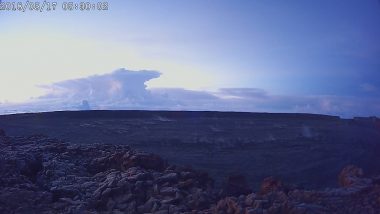After a series of smaller eruptions, Hawaii’s Mount Kilauea volcano saw what geologists call an ‘explosive eruption’ which sent ash and debris flying 30,000 feet up in the sky. That is just below cruising altitude for most jetliners.
The volcano is located on Hawaii's Big Island, and the resulting plume is expected to cover the surrounding area, according to the Hawaiian Volcano Observatory.
The US Geological Survey (USGS) says the eruption took place at 04:15 local time (14:15 GMT). A red aviation code had already been issued - warning pilots to avoid the potentially damaging ash cloud. "At any time, activity may again become more explosive, increasing the intensity of ash production and producing ballistic projectiles near the vent," the USGS said. "Ballistic projectiles may be produced should steam-driven explosions occur. Impacts will be limited to an area around Halemaumau."
The Ash3D computer simulation shows how far ash might travel and how much ash might fall to the ground. Around Kīlauea, the blue inner line is 1/32 inch possible and outer line is a trace (1/256 inch). Local conditions may vary. https://t.co/in65qavI9b pic.twitter.com/r0hRKO0A6X
— USGS Volcanoes🌋 (@USGSVolcanoes) May 17, 2018
Recent explosions have been steam-driven, occurring when water beneath the ground or on the surface is heated by magma, lava, hot rocks or new volcanic deposits, the USGS says. While the ash being launched into the sky is not poisonous, Hawaii County officials have warned residents about toxic sulfur dioxide seeping out of 21 fissures caused by the volcano.
"Severe conditions may exist such as choking and inability to breathe," the county's Civil Defense Agency said Wednesday. "This is a serious situation that affects the entire exposed population."
Kilauea’s eruption was also seen from the international space station. Two astronauts aboard the International Space Station shared photos of their view of the massive smoke plume on Hawaii’s Big Island.
It is easy to see the activity on Hawaii’s #Kilauea Volcano from @Space_Station. We hope those in the vicinity of the eruption can stay out of harm’s way. pic.twitter.com/osTn3fH073
— A.J. (Drew) Feustel (@Astro_Feustel) May 14, 2018
The astronauts, who launched into space in March on Expedition 55/56, spotted signs of the volcanic eruption over the weekend. The astronauts were carried to the ISS by a Russian Soyuz spacecraft that had a radio callsign “Hawaii.” Ricky Arnold, another NASA astronaut aboard the ISS, tweeted two images of the plume of smoke as the space station “flew over our namesake.”
We launched to @Space_Station on a spacecraft called “Hawai’i”. We flew over our namesake today and are sending much aloha to everyone there. The plume from #Kilauea is visible from space. pic.twitter.com/r76F9HO0Jg
— Ricky Arnold (@astro_ricky) May 12, 2018
Kilauea is one of five active volcanoes on the island of Hawaii. It is one of the most active volcanoes in the world and has been erupting continuously, though not explosively, for more than 30 years. Its last explosive eruption took place in 1924.
(The above story first appeared on LatestLY on May 18, 2018 03:28 AM IST. For more news and updates on politics, world, sports, entertainment and lifestyle, log on to our website latestly.com).













 Quickly
Quickly



















